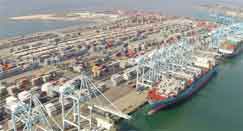US ports are well behind global peers in terms of container handling productivity.
That is certainly in large measure due to the lack of automation at US ports versus many of those in Asia and Europe.
Supply Chain Digest Says... |
|
|
There have been moves to automate container handling at some terminals at the sprawling ports of Los Angeles and Long Beach, and contracts with the International Longshore and Warehouse Union (ILWU) allow automation – though that "concession" from the union came at a steep price.
And regardless what the contract says, the ILWU is fighting hard to block plans for automation at a third of the complex's 13 terminals.
APM Terminals recently received permission from the Port of Los Angeles to automate the Pier 400 terminal, specifically for handling refrigerated containers (reefers). The plan in part involves use of automated straddle carriers to lift containers onto truck chassis.
That after container handling automation had been deployed in recent years at the TraPac terminal in the Port of LA and the Long Beach Container Terminal.
According to the Journal of Commerce, West Coast ports first secured the right to automate in contracts with the ILWU in 2008. That contract allowed traditional dockworkers to be replaced by automation.
But that concession was only secured by port and terminal operators agreeing to more than a 40% increase in pension contributions, a guaranteed 40-hour work week for life for all registered dockworkers, and increased jurisdiction for the ILWU over maintenance and repair work.
In fact, the JOC says that since the 2008 contract was signed, the terminals have paid an additional $800 million in pension contributions, even as there have been very little in in the way of automation.
And now that APM moves to automate, the union is fighting the automation anyway.
After port authorities approved the APM plans, the ILWU made a petition to the Los Angeles Board of Harbor Commissioners whose members are appointed by the mayor. In late January, the port commission postponed consideration of the permit from its agenda and will take it up again on March 21.
At the January meeting, ILWU Local 13 President Mark Mendoza. "Automation is not good. It's not good for the community; it's not good for labor, it's not good for America."
The union is arguing that the construction permit issued to APM Terminals by port to build fences, antennas, and electrical conduits violates California law overseeing the coastline.
(See More Below)
|
CATEGORY SPONSOR: SOFTEON |
|
|
|
|
|
APM naturally disagrees, seeing the argument as bogus, noting the contact not only allows automation, but contains language saying that dockworkers "will not interfere with implementation."
 Interestingly, new rules at the port relative to curbing CO2 emissions are central to APM's automation plans. Interestingly, new rules at the port relative to curbing CO2 emissions are central to APM's automation plans.
The JOC notes that 2017 Clean Air Action Plan requires terminals to operate zero-emission equipment by 2030, a mandate that will require replacement of existing container-handling equipment – a move that could costs as much as $14 billion in total.
Those costs have to recouped somehow, and given intense competition between ports, the money is unlikely to come from higher rates on the ocean carriers. That leaves reducing labor costs.
The unions thinks the costs of the new low emission equipment is a smoke screen.
"For the terminal operators to use clean-air action plan that we worked so hard to develop here in both ports as an excuse to eliminate our jobs to me is very bad decision on their part," said Danny Miranda, president of Foreman's Local 94. "It's about our livelihood and our jobs."
Also interesting, the new 2018 contact between East Coast ports and the ILA union does not really allow for new automation.
The ILA union chief Harold Daggett recently said that ILA productivity would be "far better than any robot or equipment would" could produce.
Do you think the union will block West Coast port automation? Let us know your thoughts at the Feedback section below.
Your Comments/Feedback
|